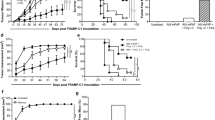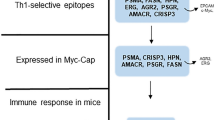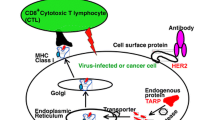Abstract
Tumor protein D52 (TPD52) is involved in cellular transformation, proliferation and metastasis. TPD52 over expression has been demonstrated in several cancers including prostate, breast, and ovarian carcinomas. Murine TPD52 (mD52) has been shown to induce anchorage independent growth in vitro and metastasis in vivo, and mirrors the function and normal tissue expression patterns of the human orthologue of TPD52. We believe TPD52 represents a self, non-mutated tumor associated antigen (TAA) important for maintaining a transformed and metastatic cellular phenotype. The transgenic adeno-carcinoma of the mouse prostate (TRAMP) model was employed to study mD52 as a vaccine antigen. Naïve mice were immunized with either recombinant mD52 protein or plasmid DNA encoding the full-length cDNA of mD52. Following immunization, mice were challenged with a subcutaneous, tumorigenic dose of mD52 positive, autochthonous TRAMP-C1 tumor cells. Sixty percent of mice were tumor free 85 days post challenge with TRAMP-C1 when immunized with mD52 as a DNA-based vaccine admixed with soluble granulocyte-macrophage colony stimulating factor (GM-CSF). Survivors of the initial tumor challenge rejected a second tumor challenge given in the opposite flank approximately 150 days after the first challenge, and remained tumor free for more than an additional 100 days. The T cell cytokine secretion patterns from tumor challenge survivors indicated that a TH1-type cellular immune response was involved in tumor protection. These data suggest that mD52 vaccination induced a memory, cellular immune response that resulted in protection from murine prostate tumors that naturally over express mD52 protein.






Similar content being viewed by others
Abbreviations
- TPD52:
-
Tumor protein D52
- mD52:
-
Murine TPD52
- hD52:
-
Human TPD52
- TRAMP:
-
Transgenic adenocarcinoma of the mouse prostate
- TAA:
-
Tumor associated antigen
References
Myllykangas S, Himberg J, Bohling T, Nagy B, Hollment J, Knuutila S (2006) DNA copy number amplification profiling of human neoplasms. Oncogene 25:7324–7332
Rodriguez V, Chen Y, Elkahloun A, Dutra A, Pak E, Chandrasekharappa S (2007) Chromosome 8 BAC array comparative genomic hybridization and expression analysis identify amplification and overexpression of TRMT12 in breast cancer. Genes Chromosomes Cancer 46:694–707
Hicks J, Krasnitz A, Lakshmi B, Navin NE, Riggs M, Leibu E, Esposito D, Alexander J, Troge J, Grubor V, Yoon S, Wigler m, Ye K, Borresen-Dale AL, Naume B, Schlicting E, Norton L, Hagerstrom T, Skoog L, Auer G, Maner S, Lundin P, Zetterberg A (2006) Novel patterns of genome rearrangement and their association with survival in breast cancer. Genome Res 16:1465–1479
Balleine RL, Fejzo MS, Sathasivam P, Basset P, Clarke CL, Byrne JA (2000) The hD52 (TPD52) gene is a candidate target gene for events resulting in increased 8q21 copy number in human breast carcinoma. Genes Chromosomes Cancer 29:48–57
Boutros R, Fanayan S, Shehata M, Byrne JA (2004) The tumor protein D52 family: many pieces, many puzzles. Biochem Biophys Res Commun 325:1115–1121
Byrne JA, Tomasetto C, Granier JM, Rouyer N, Mattei MG, Bellocq JP, Rio MC, Basset P (1995) A screening method to identify genes commonly overexpressed in carcinomas and the identification of a novel complementary DNA sequence. Cancer Res 55:2896–2903
Pollack JR, Sorlie T, Perou CM, Rees CA, Jeffrey SS, Lonning PE, Tibshirani R, Botstein D, Borresen-Dale AL, Brown PO (2002) Microarray analysis reveals a major direct role of DNA copy number alteration in the transcriptional program of human breast tumors. Proc Natl Acad Sci USA 99:12963–12968
Wang R, Xu J, Saramaki O, Visakorpi T, Sutherland WM, Zhou J, Sen B, Lim SD, Mabjeesh N, Amin M, Dong JT, Petros JA, Nelson PS, Marshall FF, He Zhau, Chung LW (2004) PrLZ, a novel prostate-specific and androgen-responsive gene of the TPD52 family, amplified in chromosome 8q21.1 and overexpressed in human prostate cancer. Cancer Res 64:1589–1594
Wang R, Xu J, Mabjeesh N, Zhu G, Zhou J, Amin N, He D, Marshall FF, He Zhau, Chung LW (2007) PrLZ is expressed in normal prostate development and in human prostate cancer progression. Clin Cancer Res 13:6040–6048
Rubin MA, Varambally S, Beroukhim R, Tomlins SA, Rhodes DR, Paris PL, Hofer MD, Storz-Schweizer M, Kuefer R, Fletcher JA, Hsi BL, Byrne JA, Pienta KJ, Collins C, Sellers WR, Chinnaiyan AM (2004) Overexpression, amplification and androgen-regulation of TPD52 in prostate cancer. Cancer Res 64:3814–3822
Byrne JA, Balleine RL, Schoenberg Fejzo M, Mercieca J, Chiew Y-E, Livnat Y, St. Heaps L, Peters G, Byth K, Karlan BY, Slamon DJ, Harnett P, deFazio A (2005) Tumor protein D52 (TPD52) is overexpressed and a gene amplification target in ovarian cancer. Int J Cancer 117:1049–1054
Largo C, Alvarez S, Saez B, Blesa D, Martin-Subero JI, Gonzalez-Garcia I, Brieva JA, Dopazo J, Siebert R, Calasanz MJ, Ciqudosa JC (2006) Identification of overexpressed genes in frequently gained/amplified chromosome regions in multiple myeloma. Haematologica 91:184–191
Tiacci E, Orvietani P-L, Bigerna B, Pucciarini A, Liso A, Pacini R, Verducci B, Pulford K, Pileri S, Gambacorta M, Carbone A, Benedetti R, Sciurpi MT, Binaglia L, Byrne JA, Falini B (2005) A new monoclonal antibody (b-28p) identifies the human tumor protein D52 (TPD52) as a novel B-cell/plasma cell associated molecule with a unique expression pattern. Blood 105:2812–2820
Dave SS, Fu K, Wright GW, Lam LT, Kluin P, Boerma EJ, Greiner TC, Weisenburger DD, Rosenwald A, Ott G, Müller-Hermelink HK, Gascoyne RD, Delabie J, Rimsza LM, Braziel RM, Grogan TM, Campo E, Jaffe ES, Dave BJ, Sanger W, Bast M, Vose JM, Armitage JO, Connors JM, Smeland EB, Kvaloy S, Holte H, Fisher RI, Miller TP, Montserrat E, Wilson WH, Bahl M, Zhao H, Yang L, Powell J, Simon R, Chan WC, Staudt LM (2006) Molecular diagnosis of Burkitt’s lymphoma. N Engl J Med 354:2431–2442
Hummel M, Bentink S, Berger H, Klapper W, Wessendorf S, Barth TF, Bernd HW, Cogliatti SB, Dierlamm J, Feller AC, Hansmann ML, Haralambieva E, Harder L, Hasenclever D, Kühn M, Lenze D, Lichter P, Martin-Subero JI, Möller P, Müller-Hermelink HK, Ott G, Parwaresch RM, Pott C, Rosenwald A, Rosolowski M, Schwaenen C, Stürzenhofecker B, Szczepanowski M, Trautmann H, Wacker HH, Spang R, Loeffler M, Trümper L, Stein H, Siebert R (2006) A biologic definition of Burkitt’s lymphoma from transcriptional and genomic profiling. N Engl J Med 354:2419–2430
Loukopoulos P, Shibata T, Katoh H, Kokubu A, Sakamoto M, Yamazaki K, Kosuge T, Kanai Y, Hosoda F, Imoto I, Ohki M, Inazawa J, Hirohashi S (2007) Genome-wide array-based comparative genomic hybridization analysis of pancreatic adenocarcinoma: identification of genetic indicators that predict patient outcome. Cancer Sci 98:392–400
Skotheim RI, Autio R, Lind GE, Kraggerud SM, Andrews PW, Monni O, Kallioniemi O, Lothe RA (2006) Novel genomic aberrations in testicular germ cell tumors by array-CGH, and associated gene expression changes. Cell Oncol 28:315–326
Korkola JE, Heck S, Olshen AB, Reuter VE, Bosl GJ, Houldsworth J, Chaganti RS (2008) In vivo differentiation and genomic evolution in adult male germ cell tumors. Genes Chromosomes Cancer 47:43–55
McIntyre A, Summersgill B, Lu YJ, Missiaglia E, Kitazawa S, Oosterhuis JW, Looijenga LH, Shipley J (2007) Genomic copy number and expression patterns in testicular germ cell tumours. Br J Cancer 97:1707–1712
Hoek KS (2007) DNA microarray analyses of melanoma gene expression: a decade in the mines. Pigment Cell Res 20:466–484
Roesch A, Becker B, Bentink S, Spang R, Vogl A, Hagen I, Landthaler M, Vogt T (2007) Ataxia telangiectasia-mutated gene is a possible biomarker for discrimination of infiltrative deep penetrating nevi and metastatic vertical growth phase melanoma. Cancer Epidemiol Biomarkers Prev 16:2486–2490
Byrne JA, Mattei MG, Basset P (1996) Definition of the tumor protein D52 (TPD52) gene family through cloning of D52 homologues in human (hD53) and mouse (mD52). Genomics 35:523–532
Lewis JD, Payton LA, Whitford JG, Byrne JA, Smith DI, Yang L, Bright RK (2007) Induction of tumorigenesis and metastasis by the murine orthologue of tumor protein D52. Mol Cancer Res 5:133–144
Scanlan MJ, Gout I, Gordon CM, Williamson B, Stockert E, Gure AO, Jager D, Chen YT, Mackay A, O’Hare MJ, Old LJ (2001) Humoral immunity to human breast cancer: antigen definition and quantitative analysis of mRNA expression. Cancer Immun 1:4–20
Payton LA, Lewis JD, Byrne JA, Bright RK (2008) Vaccination with metastasis-related tumor associated antigen TPD52 and CpG/ODN induces protective tumor immunity. Cancer Immunol Immunother 57:799–811
Gingrich JR, Barrios RJ, Morton RA, Boyce BF, DeMayo FJ, Finegold MJ, Angelopoulou R, Rosen JM, Greenberg NM (1996) Metastatic prostate cancer in a transgenic mouse. Cancer Res 56:4096–4102
Foster BA, Gingrich JR, Kwon ED, Madias C, Greenberg NM (1997) Characterization of prostatic epithelial cell lines derived from transgenic adenocarcinoma of the mouse prostate (TRAMP) model. Cancer Res 57:3325–3330
Lewis JD, Shearer MH, Kennedy RC, Bright RK (2005) Surrogate tumor antigen vaccination induces tumor-specific immunity and the rejection of spontaneous metastases. Cancer Res 65:2938–2946
Li MO, Flavell RA (2008) Contextual regulation of inflammation: a duet by transforming growth factor-β and interleukin-10. Immunity 28:468–476
Gilboa E (2004) The promise of cancer vaccines. Nat Rev Cancer 4:401–411
Lewis JD, Reilly BD, Bright RK (2003) Tumor associated antigens: from discovery to immunity. Int Rev Immunol 22:81–112
Dranoff G (2002) GM-CSF-based cancer vaccines. Immunol Rev 188:147–154
Sandler AD, Chihara H, Kobayashi G, Zhu X, Miller MA, Scott DL, Krieg AM (2003) CpG oligonucleotides enhance the tumor antigen-specific immune response of a granulocyte macrophage colony-stimulating factor-based vaccine strategy in neuroblastoma. Cancer Res 63:394–399
Disis ML, Shiota FM, McNeel DG, Knutson KL (2003) Soluble cytokines can act as effective adjuvants in plasmid DNA vaccines targeting self tumor antigens. Immunobiology 207:179–186
Johnson LE, Frye TP, Chinnasamy N, Chinnasamy D, McNeel DG (2007) Plasmid DNA vaccine encoding prostatic acid phosphatase is effective in eliciting autologous antigen-specific CD8 + T cells. Cancer Immunol Immunother 56:885–895
Pavlenko M, Roos AK, Lundqvist A, Palmborg A, Miller AM, Ozenci V, Bergman B, Egevad L, Hellström M, Kiessling R, Masucci G, Wersäll P, Nilsson S, Pisa P (2004) A phase I trial of DNA vaccination with a plasmid expressing prostate-specific antigen in patients with hormone-refractory prostate cancer. Br J Cancer 91:688–694
Acknowledgments
This work was supported in part by; funds from the Southwest Cancer Treatment and Research Center, the Department of Urology at TTUHSC and by a Howard Hughes Medical Institute grant through the Undergraduate Biological Sciences Education Program to Texas Tech University.
Author information
Authors and Affiliations
Corresponding author
Rights and permissions
About this article
Cite this article
Lewis, J.D., Sullivan, L.A., Byrne, J.A. et al. Memory and cellular immunity induced by a DNA vaccine encoding self antigen TPD52 administered with soluble GM-CSF. Cancer Immunol Immunother 58, 1337–1349 (2009). https://doi.org/10.1007/s00262-009-0659-x
Received:
Accepted:
Published:
Issue Date:
DOI: https://doi.org/10.1007/s00262-009-0659-x




